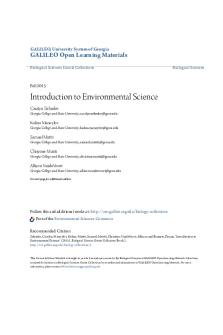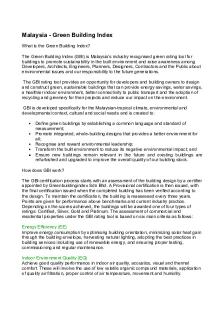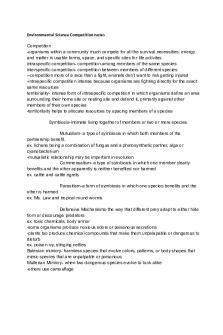GEO1330 Environmental Science Assignment 3 PDF

| Title | GEO1330 Environmental Science Assignment 3 |
|---|---|
| Course | Environmental Science |
| Institution | Florida State University |
| Pages | 2 |
| File Size | 57.3 KB |
| File Type | |
| Total Downloads | 53 |
| Total Views | 158 |
Summary
Online GEO1330 environmental science assignment 3...
Description
GEO1330 – Environmental Science Week 3 The four components of Earth’s biodiversity are functional diversity, ecological diversity, genetic diversity, and species diversity (Miller and Spoolman 2012). Functional diversity refers to the biological and chemical processes on Earth. These processes, such as the flow of energy and creation of oxygen, are necessary for humans and animals to live on this planet. Ecological diversity refers to the variety of terrestrial and aquatic ecosystems found on Earth. Tied into that is species diversity, which refers to the amount and presence of species found in different areas. There needs to be ecological diversity to provide different ecosystems for these diverse species to live in. Within species diversity, there also needs to be genetic diversity, which refers to the variety of genetic material within a population. Unfortunately, humans are interfering with the components of Earth’s biodiversity by speeding up the natural process of species extinctions and degrading ecosystems. Scientists use the acronym HIPPCO to refer to the main things causing these negative impacts (Miller and Spoolman 2009). The “H” refers to habitat destruction and fragmentation, which is when large habitats are divided or destroyed for human development like roadways, houses, or commercial buildings. The “I” stands for invasive species, which are generally introduced to new habitats by humans. The two “P” s stand for population growth and pollution. Then finally, the “C” and the “O” refer to climate change and exploitation. However, Vandermeer and Perfecto are two individuals who may say that the HIPPCO acronym does not specifically include a major problem. This problem is capitalists and agriculture. Simply put, the repeating process starts off with rich capitalists seeing an opportunity to make money by investing in the cheapest land they can find to provide whatever agricultural
product is in high demand at the time. The cheapest available property is most often found in other countries and in forest area. Therefore, trees are cut down and poor locals in the foreign area are hired to work on the farms. When the boom for that agricultural product is over, a large portion of the workers are fired and forced to find more cheap land to try to grow their own crops. In turn, more of the forest gets cut down. Technically, this issue could be placed under a broader category within HIPPCO, such as habitat destruction or exploitation. However, this problem is a serious enough issue it should have its own category, so that people are more aware of what is actually going on. References
Miller, G. Tyler, and Scott Spoolman. "How Do Humans Accelerate Species Extinction and Degradation of Ecosystem Services?" Living in the Environment. Cengage Learning, 2012. 197. Print....
Similar Free PDFs

Environmental Science
- 16 Pages

Environmental Science Module 1
- 4 Pages

Environmental Science and Engineering
- 109 Pages

Environmental Science Midterm Review
- 17 Pages

Environmental Science Questions
- 52 Pages

Environmental Science Review Sheet
- 19 Pages

Environmental Science Lecture notes
- 25 Pages

Environmental Science English Only
- 10 Pages
Popular Institutions
- Tinajero National High School - Annex
- Politeknik Caltex Riau
- Yokohama City University
- SGT University
- University of Al-Qadisiyah
- Divine Word College of Vigan
- Techniek College Rotterdam
- Universidade de Santiago
- Universiti Teknologi MARA Cawangan Johor Kampus Pasir Gudang
- Poltekkes Kemenkes Yogyakarta
- Baguio City National High School
- Colegio san marcos
- preparatoria uno
- Centro de Bachillerato Tecnológico Industrial y de Servicios No. 107
- Dalian Maritime University
- Quang Trung Secondary School
- Colegio Tecnológico en Informática
- Corporación Regional de Educación Superior
- Grupo CEDVA
- Dar Al Uloom University
- Centro de Estudios Preuniversitarios de la Universidad Nacional de Ingeniería
- 上智大学
- Aakash International School, Nuna Majara
- San Felipe Neri Catholic School
- Kang Chiao International School - New Taipei City
- Misamis Occidental National High School
- Institución Educativa Escuela Normal Juan Ladrilleros
- Kolehiyo ng Pantukan
- Batanes State College
- Instituto Continental
- Sekolah Menengah Kejuruan Kesehatan Kaltara (Tarakan)
- Colegio de La Inmaculada Concepcion - Cebu







